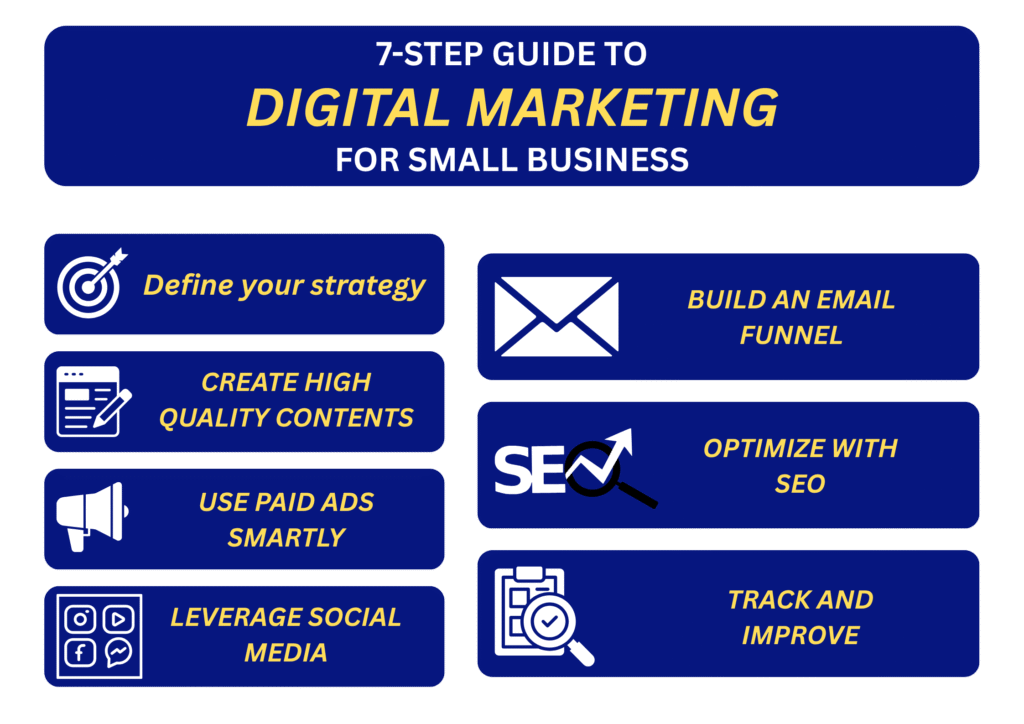
Let’s be honest—if you’re running a small business today, not having a digital presence is like being invisible. Digital marketing for small business isn’t just a trend—it’s become a must. Compared to traditional marketing, which can be pricey and hard to measure, going digital is more affordable, more targeted, and way easier to track.
To make it work, you don’t need a large staff or an enormous budget. You just need the right game plan. So, here’s a super practical 7-step checklist to help you get your digital marketing for small business efforts off the ground and growing fast.
Step 1: Set a Clear Plan for Your Digital Marketing for Small Business
Before doing anything, you need a strategy. Think of it like setting your GPS—you need to know where you’re going. What’s your goal? More traffic, more leads, more sales? Once you figure that out, you can plan the right moves.
Next, figure out who your audience is. Who are you really talking to? What are they into? What problems are they trying to solve? Build your customer profiles around this stuff—it’ll help you talk their language.
Also, pick your platforms wisely. Maybe it’s social media, SEO, content, email, or ads—or maybe a mix. Don’t try to do everything at once. Focus where it matters most.
Step 2: Create Content That Actually Helps People
Content is the heart of digital marketing for small business. Blog posts, videos, memes, social media reels—you name it. Good content builds trust, shows you know your stuff, and brings in visitors who need what you offer.
Here are a few content types to play with:
-
Educational stuff: Think how-to guides and tips
-
Entertaining stuff: Stories, behind-the-scenes peeks, memes
-
Promotional stuff: Offers, launches, testimonials
The trick? Be helpful and real. Make sure to drop in keywords too, especially on your website or blog. And don’t forget—good content gives your emails, ads, and social posts something valuable to share.
Step 3: Use Paid Ads to Get Quick Wins
Now let’s talk about paid ads. Organic traffic is great, but sometimes you need a fast boost. That’s where paid ads come in—super useful in digital marketing for small business.
Platforms like Google Ads, Facebook, and Instagram let you target specific people based on their age, location, and interests. Start small, experiment, and make adjustments as you go.
Try these ad types:
-
Google Search Ads – Show up when someone searches for something you sell
-
Display Ads – Great for visibility
-
Social Media Ads – Ideal for engaging people
-
Remarketing Ads – Remind people about you after they’ve visited your site
When done right, ads can bring serious results without blowing your budget.
Step 4: Get Social and Build Community
Social media is a crucial tool for digital marketing for small business. It’s where your customers hang out, so it makes sense to meet them there. You don’t need to be everywhere—just where it counts.
Pick platforms that match your brand. Fashion or food? Instagram. B2B or professional services? Try LinkedIn.
Tips for doing social right:
-
Be consistent
-
Use photos and videos—they grab attention
-
Respond to comments and DMs
-
Share customer stories or behind-the-scenes looks
-
Run contests or polls
And if you’ve got a little budget, boost your posts or run ads to reach even more people.
Step 5: Build an Email List (Yep, It Still Works!)
Despite its outdated vibe, email is still one of the most effective tools in digital marketing for small business. Why? Because you own your email list. No algorithms. No reach limits. Just you and your audience.
Start by giving people a reason to subscribe. Maybe it’s a free guide, discount, or useful checklist. Then send them emails that help, inform, and occasionally sell.
Your email game plan could include:
-
Welcome emails
-
Product updates
-
Tips and blog highlights
-
Special offers and sales
Tools like Mailchimp or Brevo make email marketing super easy—even if you’re just starting out.
Step 6: Boost Your Search Visibility with SEO
If someone Googles what you offer, and you don’t show up—you’re missing out. SEO is how you fix that. It’s one of the best long-term plays in digital marketing for small business.
Here’s what to focus on:
-
On-Page SEO – Determine what people are looking for with keyword research
-
On-Page SEO – Ensure that your content, meta descriptions, and titles are optimized for search engines
-
Local SEO – Set up your Google Business Profile and collect reviews
-
Content SEO – Blog about stuff your audience cares about
It takes time, but once it kicks in, SEO drives traffic 24/7 without spending a dime on ads.
Step 7: Track Everything and Keep Improving
Last but not least, measure what you’re doing. One of the biggest perks of digital marketing for small business is how easily you can track your performance.
Tools to use:
-
Google Analytics – See where your traffic is coming from
-
Google Search Console – Check your search performance
-
Social Media Insights – Know what posts work
-
Email Reports – Track opens, clicks, and conversions
Check in regularly and tweak things as needed. Small improvements over time = big results.
Why Digital Marketing for Small Business Is a Game-Changer
Traditional ads? Expensive. Hard to track. Limited reach. But digital marketing for small business? It’s flexible, cost-effective, and levels the playing field. Whether you’re just starting out or trying to scale, it gives you tools to grow faster and smarter.
Whether it’s improving SEO, building a social following, or turning leads into customers through email, digital marketing brings all the pieces together. It’s not just a marketing tactic—it’s a long-term strategy.
According to Wikipedia, digital marketing involves using the internet, mobile devices, social media, and search engines to connect with consumers. And for small businesses, it’s the perfect fit.
Wrapping It All Up
At the end of the day, digital marketing for small business isn’t a one-time thing—it’s an ongoing process. You can use this seven-step checklist as a guide: make wise plans, provide amazing content, advertise when necessary, and establish a social media following. Take advantage of email, hone your SEO abilities, and keep an eye on your progress at all times.
Start simple. Take one step at a time. All of it doesn’t have to be done today. However, with the right plan and a little persistence, even a small business may succeed online.
Want help creating your first campaign or optimizing your content? Just ask—I’ve got your back. To Explore our Services Click Here.
